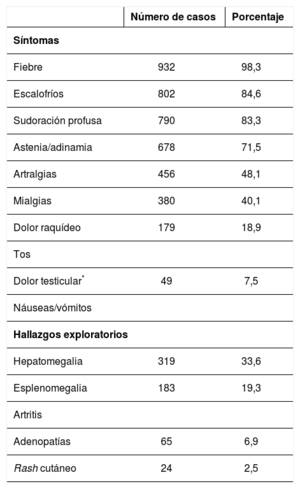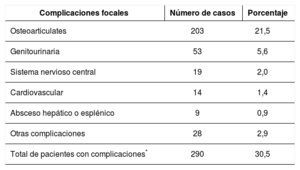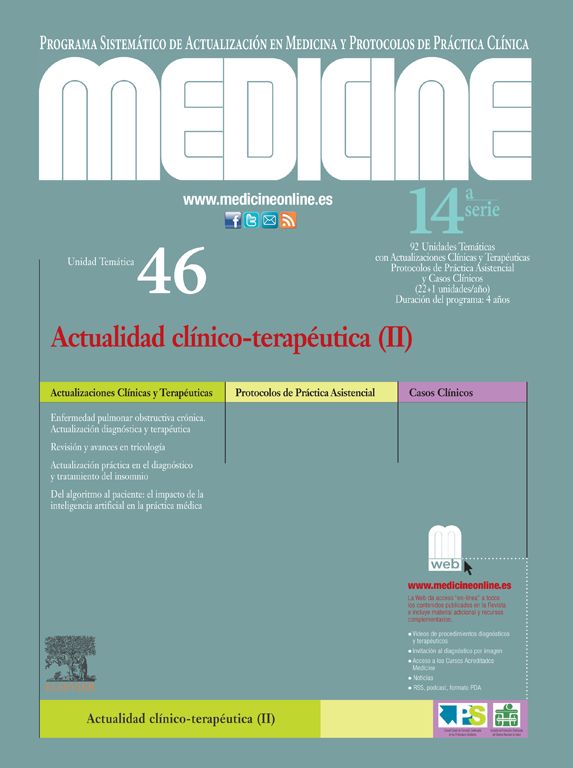La brucelosis es una zoonosis reemergente ampliamente distribuida en el planeta. Produce una alta morbilidad y pérdidas sociosanitarias muy cuantiosas en los países en los que es endémica.
EtiopatogeniaProducida por coco-bacilos Gram negativos del género Brucella, del cual existen diferentes especies con hospedadores y patogenicidad propias. B. melitensis, B. abortus y B. suis son las especies más frecuentes y B. melitensis la más patógena en seres humanos. Capaz de eludir mecanismos de la respuesta inmune, la infección por Brucella tiene tendencia a producir cuadros prolongados, recaídas y complicaciones focales.
Espectro clínico y diagnósticoHabitualmente la brucelosis se manifiesta como un cuadro febril sin focalidad aparente, de comienzo agudo o subagudo acompañado de escalofríos, sudoración profusa, artromialgias y malestar general. Aproximadamente, un tercio de los pacientes desarrollará una complicación focal a lo largo del curso evolutivo de la enfermedad. Por lo inespecífico de su espectro clínico, siempre debe intentarse el diagnóstico microbiológico, bien mediante el aislamiento del microorganismo, para lo cual la muestra más rentable es el hemocultivo, o mediante la demostración de anticuerpos específicos a títulos significativos o seroconversión.
TratamientoEl tratamiento más eficaz es doxiciclina 100 mg por vía oral cada 12 horas durante 6 semanas, junto a estreptomicina las primeras 2 semanas. Aunque algo menos efectiva, por su comodidad, doxiciclina junto con rifampicina 600-900 mg/día, ambas durante seis semanas, es una buena alternativa. El tratamiento de las complicaciones focales difiere según la localización y gravedad del caso.
Palabras Clave
Brucellosis is a re-emerging zoonosis that is widely distributed around the globe. It causes high morbidity and very substantial social and health losses in the countries in which it is endemic.
AetiopathogenesisCaused by Gram-negative coccobacilli of the Brucella genus, of which there are different species with their own hosts and pathogenicity. B. melitensis, B. abortus and B. suis are the most common species and B. melitensis is the most pathogenic in human beings. Capable of eluding immune response mechanisms, Brucella infection tends to cause prolonged symptoms, relapses and focal complications.
Clinical spectrum and diagnosisBrucellosis routinely manifests with a fever of no apparent focus of infection, of acute or subacute onset accompanied by chills, profuse sweating, arthromyalgia and general malaise. Approximately a third of patients will develop a focal complication as the disease progresses. Because its clinical spectrum is so non-specific, microbiological diagnosis must always be attempted, either by isolating the microorganism, haemoculture is the most cost-effective method, or by demonstrating specific antibodies at significant titres or seroconversion.
TreatmentThe most effective treatment is doxycycline p.o. 100 mg every 12 hours for 6 weeks, combined with streptomycin for the first 2 weeks. And for convenience, although somewhat less effective, doxycycline combined with rifampicin 600-900 mg/day, also for six weeks, is a good alternative. The treatment of focal complications varies according to their location and severity.
Keywords
Identifíquese
¿Aún no es suscriptor de la revista?
Comprar el acceso al artículo
Comprando el artículo el pdf del mismo podrá ser descargado
Teléfono para incidencias
De lunes a viernes de 9h a 18h (GMT+1) excepto los meses de julio y agosto que será de 9 a 15h










